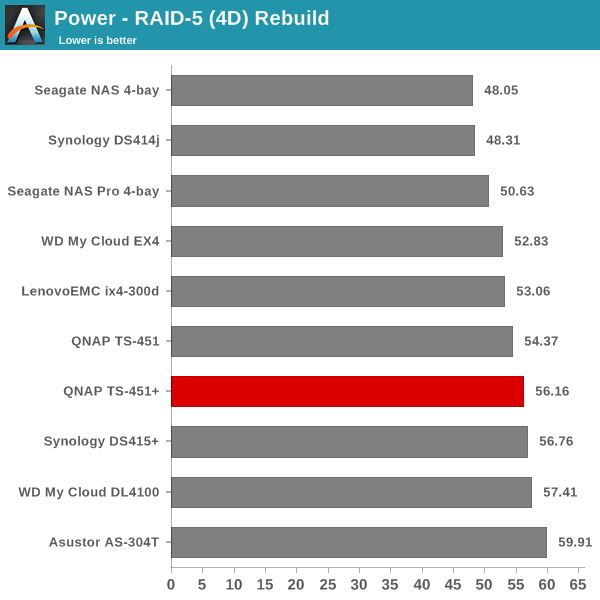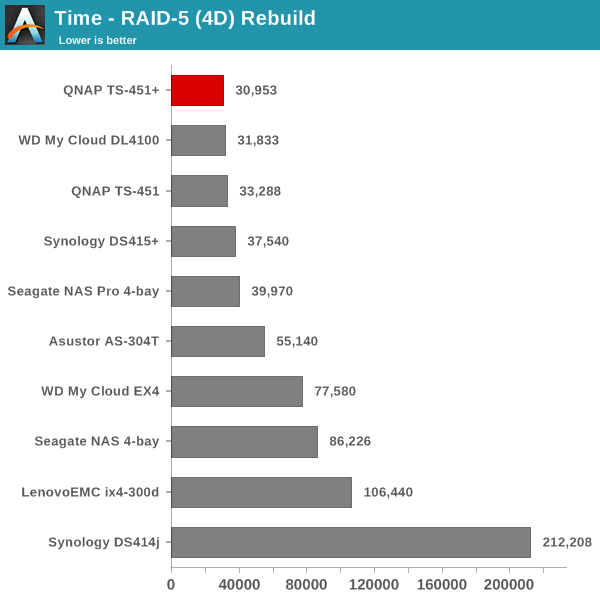QNAP TS-451+ SOHO NAS Review
by Ganesh T S on October 29, 2015 8:00 AM ESTMiscellaneous Aspects and Final Words
In order to keep testing consistent across all 4-bay units, we performed all our expansion / rebuild testing as well as power consumption evaluation with the unit configured in RAID-5. The disks used for benchmarking (Western Digital WD4000FYYZ) were also used in this section. The table below presents the average power consumption of the unit as well as time taken for various RAID-related activities. In the genera state with the hard disk powered on, but not actively reading or writing data, the power consumption was around 50 W, though it dropped to around 16 W with the disks in sleep mode.
| QNAP TS-451+ RAID Expansion and Rebuild / Power Consumption | ||
| Activity | Duration (HH:MM:SS) | Avg. Power (W) |
| Single Disk Init | - | 20.47 W |
| JBOD to RAID-1 Migration | 08:21:12 | 33.33 W |
| RAID-1 (2D) to RAID-5 (3D) Migration | 20:52:59 | 44.11 W |
| RAID-5 (3D) to RAID-5 (4D) Expansion | 22:35:18 | 53.09 W |
| RAID-5 (4D) Rebuild | 08:35:53 | 56.16 W |
The graphs below show the power consumption and rebuild duration when repairing a RAID-5 volume for the various 4-bay NAS units that have been evaluated before.

The TS-451+ takes very little time to rebuild the NAS volume. However, the power consumption is on the higher end of the spectrum. Overall, the efficiency (energy consumerd in the process) should definitely be in QNAP's favor.

Concluding Remarks
The TS-x51+ series is the latest addition to QNAP's lineup targeting the home users / SOHO market. There is a distinct multimedia focus with the bundled IR remote. Braswell would have further strengthened the multimedia credentials, but QNAP has opted to strangely continue with Bay Trail for this product line. Other than that, the performance of the unit is just slightly better than that of the TS-451 that we evaluated last year.
QNAP's firmware, though, has been improving by leaps and bounds with every release. QTS 4.2 has brought in a host of new features. The NAS is pretty flexible and provides a large number of add-ons as well as third party apps. The TS-451+ is also capable of supporting multiple virtual machines, though, with just two network ports, it is unlikely that consumers will want to run more than one. Earlier this year, QNAP launched Container Station, which adds Docker functionality to QTS. Obviously, QNAP's transcoding functionality that takes advantage of Intel's Quick Sync engine is present in the TS-451+ also. Along with the Hybrid Desk app (Chrome / Kodi etc.) and QvPC technology, the NAS can be used just like a PC for most purposes.
The above advantages aside, there are certain areas where QNAP could improve. One of the main points is the quality of the drive bays in the TS-451+. At the target price point, we need metal drive trays. On a more generic note, QNAP needs to move to Braswell soon while also delivering support for the btrfs file system (in addition to the currently supported EXT4).
The TS-x51+ series has four members - the TS-451+-8G-US coming in at $649, the TS-451+-2G-US coming in at $529, the TS-251+-8G-US coming in at $499 and the TS-251+-2G-US at $399. The price point is definitely an issue, as the TS-453 Pro with 8 GB of memory is currently available in Amazon for $645. For a similar amount, users can get two extra LAN port as well as an extra USB 3.0 port, and there is no power brick to deal with. The only downside is that there is no bundled IR remote in the TS-453 Pro. For users who don't need the IR remote control capabilities (i.e, those who are not going to hook up the NAS to a display and run XBMC / Kodi directly on the NAS), the TS-453 Pro is a much better choice in all respects.
In terms of firmware capabilities and performance for this market segment, there is nothing to complain about in the QNAP TS-451+. The NAS with the included IR remote is attractive for multimedia enthusiasts who want to use the unit also as a media player. At the currently available price points, we would recommend the TS-453 Pro over the TS-451+. For the TS-451+ to become a compelling choice, the pricing aspect needs to be addressed.











34 Comments
View All Comments
mwituni - Thursday, November 19, 2015 - link
As an existing QNAP user, I don't know how any QNAP NAS's can be seriously considered for any awards, nor why they do so well on reviews.They entice buyers with fancy options, but are not interested in developing applications users need.
SVN (Subversion Source Control) is the most popular and source control software in use, yet QNAP have been promising a proper SVN-server application since 2009, and still not delivered! How can users take them seriously - they're obviously not interested in developing applications the community needs, only the minimum needed to trick buyers into purchasing and evaluators to award prizes. They claim you can install SVN by an outdated method - which is very risky and outdated by a few years, and in my experience does not work at all.
They have a GIT client, so can claim they "have" source control applications. But no SVN support.
Their marketing department needs to kick the development team into gear.
krazyderek - Sunday, January 10, 2016 - link
maybe you should should join everyone else and switch to GIT ;) https://git-scm.com/book/en/v1/Git-and-Other-Syste...gnalley - Saturday, January 23, 2016 - link
Don't try to use this device as a standalone windows domain controller. The SAMBA and DHCP implementations are missing two CRITICAL components for it to work.Samba is missing the ability to do DNS Forwarders...and DHCP does not allow you to input the OPTIONS command. Both of these functions are critical to having a working solution. If you want a standalone MS Domain Controller that works. Look elsewhere.
StaksOnStaks - Wednesday, June 1, 2016 - link
I noticed the model tested was the 8GB. Any sense of how the performance would compare to the 2GB? For example, I noticed the Synology DS415+ was very close in the performance, but only has 2GB. Would the 2GB version of the QNAP TS-451+ perform as well compared to the Synology DS415+?